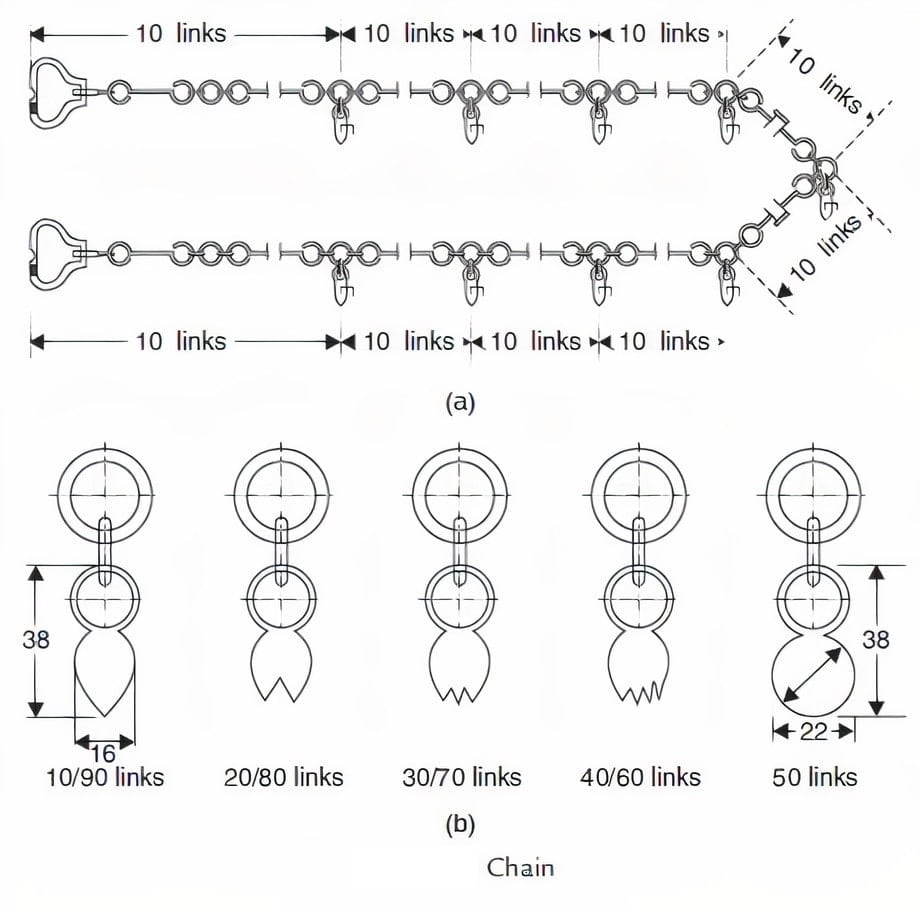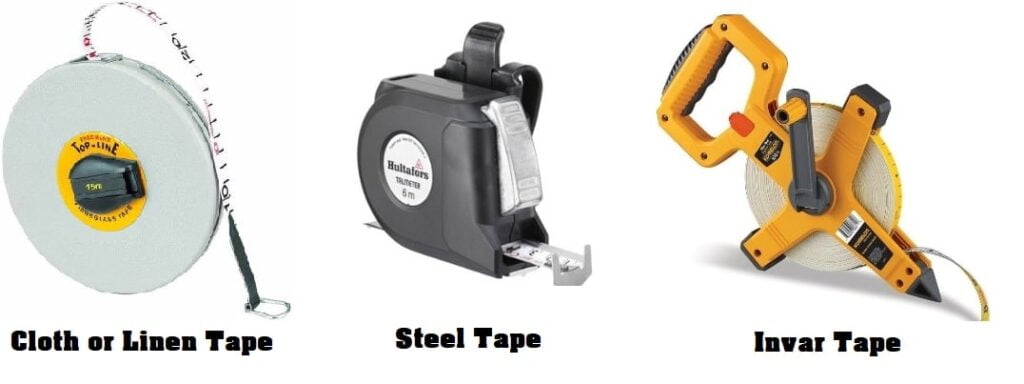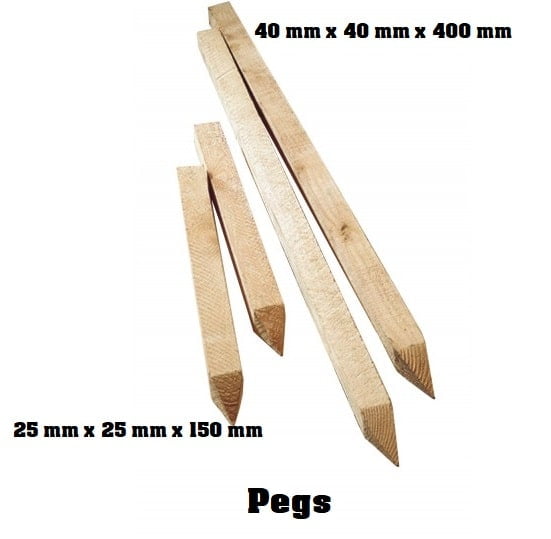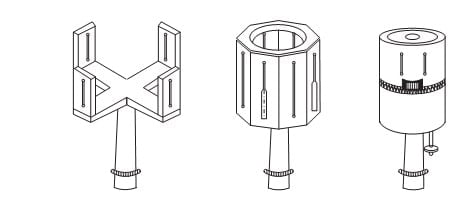Equipment Used In Chain Surveying
In chain or tape surveying, obviously a tape or a chain is required. But in addition to that, the following instruments and accessories are also required:
| (a) Pegs | (b) Arrows | (c) Plumb bob |
| (d) Ranging rods | (e) Offset rods | (f) Clinometer |
| (g) Cross-staff | (h) Optical Square | (i) Prism Square |
Surveying Chain
A Surveying Chain, or simply a chain, is commonly used for measurement of distances where a very high accuracy is not required. A chain consists of a number of large links made of galvanised mild steel wire of 4mm diameter.

Types of Chain
The various types of chains are as mentioned under below:
Revenue chain-33 ft long (16 links)= 10.06 meter.
Gunter’s chain-66 ft long (100 links)= 20.12 meter.
Engineer’s chain – 100 ft long (100 links)= 30.48 meter.
Metric chain-30 m (150 links) or 20 m (100 links)
Note:
1 mile= 80 Gunter’s chain
1 acre= (10 Gunter’s chain)2
The surveying chain is not as accurate as a steel tope or steel band.
Suitability of Chain
1). It can be read easily.
2). It is suitable for rough use only.
3). It can be easily repaired in the field.
Unsuitability of Chain
1). As being heavier, it sags considerably when suspended in air.
2). It is suitable for ordinary work only because the length of links gets altered by shortening/lengthening.
⇒As per IS specifications, every metre length of the chain should individually be accurate to within ±2 mm when measured under a tension of 80 N (8 kgf).
⇒The overall length of the chain should be within the limits given below
- 20 m ±5 mm for 20 m chain
- 30 m ±8 mm for 30 m chain.
Units of Measurement.
1 ft = 0.3048 m
1 yard = 3 ft
1 sq mile = 2.590 km²
1 acre = 43,560 sq ft
1 mile = 5280 ft
1 mile = 1.609 km
1 sq mile = 640 acres
1 hectare = 2.471 acres
Tapes
Tapes are available in a variety of materials, lengths and weights. The different types of tapes used in general are discussed as below.

1). Cloth or Linen Tape
These tapes are made of linen /cloth or synthetic material and are available in lengths of 10-30 m and widths of 12-15 mm.
Disadvantages of Cloth or Linen Tape are:
- It is affected by moisture and gets shrunk.
- Its length gets changed by stretching.
- It is likely to twist during measurement.
2).Metallic Tape
This is a linen tape with brass or copper wires woven into it longitudinally to reduce stretching. The wires are not visible because it is varnished. These are available in lengths of 20-30 m.It is an accurate measurement device and is commonly used for measuring offsets. As it is reinforced with brass or copper wires, all the defects of linen tapes are overcome.
3). Steel Tape
It is more accurate than metallic tapes. They are made up of steel or stainless steel strips. These are available in lengths of 1-50 m and width of 6-10 mm. At the end of the tape a brass ring is attached, the outer end of which is zero point of the tape. Steel tapes cannot be used in the ground with vegetation and weeds.
4). Invar Tape
These are made up of an alloy of nickel (36%) and steel (64%). These tapes have a very low coefficient of thermal expansion (0.122 x 10-6/°C). These are available in lengths of 30, 50 and 100 m and width of 6 mm.
Advantages of Invar Tape
- Highly precise.
- It is less affected by temperature changes in comparison to the other tapes.
Disadvantages of Invar Tape
- It is soft hence deforms easily.
- It requires much attention in handling, hence not used for ordinary works
Accessories for Chaining
Pegs
Pegs are used to mark the survey stations and end points of survey lines on the ground. These pegs are also used to mark the intersection of lines and other such points which are more or less permanent. Pegs are generally made of wood (preferably hard timber) with square sections and tapers at one end. The most common size of these pegs are 25 mm x 25 mm x 150 mm long, 40 mm x 40 mm x 400 mm long.

Arrows
Arrows are used to mark the position of the end of the chain or tape on the ground. These arrows are made of hard tempered steel wire (minimum tensile strength of 700 N/mm²) of 4 mm diameter. Generally 10 arrows are provided with a single chain. The arrow is pointed at one end and is provided with a loop at the other end. The length of the arrow varies from 250 mm to 500 mm.

Ranging rods
The process of locating a number of points on a long survey line is called Ranging or Ranging out.
Ranging rods are required generally in cases where the length of chain or tape is small as compared to distance between the two stations.
Ranging Rods are 30 mm in diameter and 2 or 3 m long. These are painted with alternate bands of either red and white or black and white of 200 mm length such that at sometimes the rod can also be used for the rough measurement of short lengths.
Offset rods
These are similar to ranging rods with only difference, that they are being provided with hook or opening at the top and two narrow vertical slots at right angle to each other at eye level. It is used to align the offset line
Plumb bob
A freely suspended plumb bob always aligns itself in the direction of gravity and points towards the center of the earth. It indicates whether a line is truly vertical or not. Plumb bobs are used to place the tape directly over a point when a tape or a chain is suspended over it. These are also used to transfer the point on the tape to the ground (generally in case of sloping ground). In surveying, plumb bob is mainly used for centering the instrument like magnetic compass, theodolite, plane table etc.
A plumb bob is made up of bronze or brass in the shape of an inverted cone. A hook is provided at the top to attach a string.The weight of the plumb bob varies from 2 N to 5 N. The length of the bob is about 50 mm.

Clinometer
A Clinometer is used for measuring the angle of slope of the ground. A light plumb bob is suspended from the centre of the semi-circle. When the ground surface is horizontal, then the plumb bob marks zero reading. When the ground surface is sloping, the plumb bob marks the corresponding reading and thus gives the slope of the ground.

Cross-staff
It is a simple instrument used for setting out the offsets to the chain line from a given point. It is also used for setting out a right angle.For very high accuracy demanding works, a theodolite is used to lay off right angles to the chain line.

Optical Square
An optical square is a small pocket instrument, slightly larger than a watch. It is used for setting out right angles. The optical square is more convenient and more accurate than a cross staff. There are two mirrors, H and I, placed vertically above the base and inclined at 45° to each other. The mirror H is silvered on the top and unsilvered at the bottom where mirror I is fully silvered.
It works on principle of “Double Reflection”, if a ray of light undergoes two successive reflections in a plane at right angles to each of the two plane mirrors, the angle between the incident ray and the reflected ray is twice the angle between the mirrors. In the optical square, as the angle between the mirrors is 45°, the reflected ray is perpendicular to the incident ray.
Prism Square
The prism square is based on the same optical principle as that of an optical square. In a prism square, a prism is used which has two reflecting surfaces I and H fixed at 45°.
Chain Survey Instruments
| S,No | Name of Instruments | Used For |
| 1 | Pegs | Main Station |
| 2 | Arrows | Intermediate Station |
| 3 | Plumb bob | Centering, Perfect Vertical Line |
| 4 | Ranging rods | Ranging |
| 5 | Offset rods | Ranging |
| 6 | Clinometer | Angle of slope of the ground |
| 7 | Cross-staff | 90 degree angle measurement |
| 8 | Optical Square | 90 degree angle measurement |
| 9 | Prism Square | 90 degree angle measurement |
Distance Measuring Device
1). Pacing : Measured Step by Step
2). Passometer : Attached to leg which automatically registers numbers of pacing (Distance=n ×Avg. length of pace)
3). Pedometer : Similar to Passometer, but it registers total distance
4). Speedometer : It registers number of revolutions of a wheel (Distance= n* Circumference)
5). Chains : Distance measured in terms of Chain and links
6). Tape : Distance measured directly in meters
7). Tacheometer
8). Theodolites
9). Electronic Distance Measurement
10). Total Station
Instruments Used for Various Types of Measurement
(a) For horizontal distance measurement: Tape, chain, tacheometer, EDM etc.
(b) For horizontal angle measurement: Magnetic compass, theodolites, total station, sextant etc.
(c) For vertical distance measurement: Tacheometer, levelling instruments like dumpy level etc.
(d) For vertical angle measurement: Sextant, clinometer, theodolite etc.
Most important for researchers in the field of civil engineering